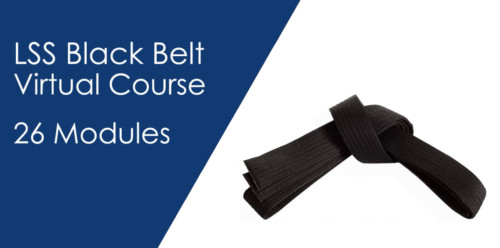see what our graduates have to say:
This is a great introduction to Design of Experiments and the statistics involved therein. Don’t feel like you will get lost, the course is done in a very tactful manner that teaches as you go.
The course it is well presented and detailed and well worth it to establish a base understand of the DoE principles and applicable to just about any project that requires optimization.
The DOE Pro and SPC XL software is amazing! Used Minitab and JMP previously, and the user interface for this new software makes it far easier to use.
Where I benefited the most from this course was working through the many examples that were provided during the course. The content was very well explained which made working through the examples, while the instructor presented them, easy to follow and very helpful.
I would highly recommend this Greenbelt training. The course and tools are designed to bring success to the students & businesses. The skills learned will bring value throughout your career.
Highly recommend especially if your work is directly related to designing experiments with longer run times. This course will assist in pointing out the important factors and how to go on about being most efficient while maintaining a high confidence level.
Instructor explained the fundamentals as well as the application of DOE very well. He also helped the students understand how to apply DOE or MSA to their own systems.
Highly recommended! The content was explained in an easy-to-understand way, and was practically applied so that you could see it in action.
The instructor was able to provide feedback/applications for ‘real world’ examples of the subject matter to our processes.
Instructor clearly has a wealth of knowledge and experience and he was able to convey to us some very complicated ideas and concepts through these examples, as well as his excellent presentation skills.
Don’t waste your time shopping around, partner with Air Academy. We wasted three months vetting other companies.
Lean Six Sigma
Become the change agent your organization needs you to be, seizing new opportunities with Lean Six Sigma
Lean Six Sigma is an evidence-based, data-driven process improvement philosophy. It helps lower variance, waste, and cycle time while fostering job uniformity and flow and boosts customer satisfaction and bottom-line success rates, giving it a competitive edge. Lean Six Sigma is estimated to have increased customer satisfaction by up to 90%.
With the support of government initiatives and experienced experts, this approach can lead to successful workplace implementations and sustainable growth. It is applicable in places where there is variance and waste, and ideally, every employee should be engaged in various aspects of their responsibilities. By following the right steps and resources, such as incorporating value stream mapping, kaizen, and problem-solving techniques in different phases of the workflow, the deployment of Lean Six Sigma can greatly improve efficiency and save costs within an organization while also reducing variability.
As a synthesis of management ideas and procedures that have their roots in Japan, Lean Six Sigma may be traced back to the United States in the 1980s. Then, American managers embraced several Japanese production concepts like “kaizen,” which focused on minimizing waste through non-value-adding tasks to compete with Japan’s superior goods. Employees were encouraged to be part of a culture that continually sought better solutions, taking into account the similarities and differences in the ability of everyone to contribute. Over the years, especially in the 1990s, continuous improvement tools and methods were further developed by Deming, Juran, Shewhart, Ishikawa, Shingo, and Taguchi, informed by data analysis to ensure a targeted focus on problem areas. Over 70% of Fortune 500 companies have adopted Lean Six Sigma.
A team of professionals and experts, equipped with vast expertise, championed this method through insightful articles and teachings. Large American firms greatly benefitted from these new options, following a model that revolved around enhancing the customer experience while taking into account the diverse needs of everyone involved. Air Academy Associates was among the early providers to teach this methodology and, in fact, taught the first Black Belts at Motorola, led by Bill Smith, known as the Father of Six Sigma. These consulting firms helped to create a culture of continuous improvement that engaged employees to actively participate in finding solutions, considering the abilities of each team member.
Lean Six Sigma Training
Lean Six Sigma training combines the time-tested tools and proven elements of traditional Lean with traditional six sigma into a powerful, symbiotic process improvement methodologies. Lean six sigma focuses on enhancing customer satisfaction, decreasing defect rates and wasted efforts, reducing cost and cycle time, while also generating quality improvement in process performance. The extensive knowledge of professionals and experts is instrumental in building a strong foundation for these methodologies throughout various phases of implementation, and the concept relies heavily on employees’ insights and dedication to achieve success.
Participants in our online-instructor led lean six sigma training learn enhanced problem-solving skills using the basics of define, measure, analyze, improve and control (DMAIC) methodology and tools for achieving better, faster, and lower-cost products and processes. Participants learn to select and apply the right tools for a lean six sigma project, guided by team members with the expertise to provide appropriate support. Students learn the value of continuous improvement through these analytical skills and practical application of data analysis, taking into account each individual’s unique abilities. This training is ideal for anyone who desires to become a practitioner of the lean six sigma methodology and toolset and who will be leading lean six sigma projects within an organization.
Lean Six Sigma Tenets
The “lean” management philosophy focuses on minimizing and eliminating eight types of waste, sometimes called “DOWNTIME.” It stands for faults, overproduction, waiting, underutilization of talent, transportation, inventory, motion, and extra-processing. Any technique, policy, or device that assists in finding and getting rid of waste is known as “lean,” and value stream mapping is one such tool employed in this phase of the process.
In 1986, a Motorola engineer by the name of Bill Smith, now regarded as the Father of Six Sigma, introduced statistical principles to the company, successfully reducing defects to 3.4 per million- ultimately achieving a Six Sigma level of performance. This achievement demonstrated the similarities between the Lean and Six Sigma approaches, and the ability of both to drive significant improvements in performance.Consultants utilize these tools and methods to enhance manufacturing and transactional processes called Six Sigma, often using data analysis to pinpoint areas for improvement. They work in parts to create a roadmap for success, while continuously seeking opportunities for rework and improvements in the system.
By locating and removing the root causes of errors and variances in production and business processes, it seeks to enhance the processes. Lean Six Sigma makes use of the DMAIC stages from Six Sigma, utilizing the expertise of trained professionals and team members for optimal results, while streamlining the workflow and handling major responsibilities efficiently. The culture of continuous improvement and focus on solutions driven by data analysis empowers employees to contribute meaningfully to the organization’s success, enriching their education and growth opportunities.
Integrating Lean management ideas and Six Sigma tools and methodologies explains which processes are prone to variation within project teams while providing details on reasons behind these variations. To ensure ongoing progress and effectiveness, it then lowers such variances with expert precision. These experts have a solid grasp on the controls and methodologies, constantly evaluating and refining the available solution options, aiming to identify the root cause of any issues and taking the initiative to address them.
Lean Six Sigma Levels
Belt” levels are used in lean six sigma training to represent proficiency virtually identical to six sigma.
- Yellow Belt: Understanding of Lean Six Sigma
- Green Belt: Emphasis on the utilization of tools, DMAIC, and Lean concepts
- Black Belt: Full-time project leader
- Master Black Belt: A Black Belt with at least two years of experience and is capable of imparting Lean Six Sigma principles to others.
Lean Six Sigma Certification
Air Academy Associates offer certification at the lean six sigma green belt, Lean Six Sigma black belt, and Lean Six Sigma master black belt levels. In addition, white and yellow belts receive certificates of completion and credit toward Lean Six Sigma green belt certification. These certifications provide individuals with a stepping stone to enhance their expertise and contribute to a better customer experience within their organizations.
Our certification program, with its rich history and proven track record of producing a difference in business results, requires completion of the in-depth training, passing 70% on the course exam, and successfully reporting the approved project. Furthermore, students must provide the necessary details showcasing their understanding of the material and answering any pertinent questions. Air Academy consultants/mentors, with their extensive work experience, work closely with the students to guide and support their initiatives, ensuring ultimate success in reaching the certification.
Students with an Air Academy Associates certification are recognized globally and have met higher standards than many other programs. Their accredited work experience and newfound skills in driving various initiatives can help them address the challenges and changes in their respective industries, making a noticeable effect on their organizations. These certified individuals possess the knowledge and expertise to tackle various things in their field.
Get started today on your training and certification journey and witness the difference it makes in your professional growth. Whether it is through self-study materials like books or guided instruction, raise your expertise level and earn that valuable certificate.
Principles of Scientific Management, written by Frederick Winslow Taylor, served as the foundation for developing Continuous Improvement as a company strategy and discipline. Taylor defined business as a collection of related activities or workflows that need to be kept in check with data, setting the stage for transformative changes in operating procedures.
Walter Shewhart created a set of management practices for process control and ongoing improvement in the 1930s, building upon Taylor’s ideas on data-driven business procedures. Utilizing the results of Shewhart’s work, the engineering and management disciplines of Quality Assurance and Quality Control are used by most firms today, tackling new challenges head-on.
Following World War II, Edward Deming, a student, and protégé of Shewhart’s transformed the Japanese automobile industry into a global leader in engineering and quality by using these ideas.
Lean was created at Toyota as a component of the Toyota Production System, based on Shewhart and Deming’s work. Deming had Toyota as a customer, and Toyota established its operational management procedures on the ideas he propagated. The reduction of waste is the primary Lean driver. The phrase “a collection of instruments that aid in the discovery and the gradual removal of waste” is a fair way to summarize the Lean methodology.
A waste process denotes the creation of large-scale, high-quantity waste by an organization engaged in large-scale, high-quantity manufacturing, such as Toyota. No business wants to carry this. Using tools in the Lean methodology, people examine the industry and devise a combination of initiatives that increase efficiency.These approaches aim to create a profound impact on their organization, with trainers and learners playing an essential role in achieving this goal.
The term “Lean Enterprise” refers to a manufacturing approach that, by definition, states that every element of a company that does not directly help a final product is redundant. This perspective emphasizes the elimination of waste in all things related to the organization’s operations. Lean businesses prioritize value generation while cutting down waste and unnecessary procedures, tackling challenges stemming from inefficient operations, and recognizing the importance of individual perspectives in the workplace. In this learning process, practice is crucial for learners to internalize the concepts and for trainers to effectively fulfill their role.
Depending on how much of their discretionary income they are willing to spend on an item, customers choose what product or service features are the most valued. This knowledge helps in designing an ideal set of offerings that align with customer expectations, ultimately serving the goal of satisfying both parties.
The Lean business aims to remove “Muda,” a Japanese term that loosely translates to “waste” and refers to the inefficiencies that may be drastically reduced or canceled by significantly appropriating concepts from Lean Six Sigma principles in the right place. Lean is focused on eliminating waste and non-value-added activities, while Six Sigma is focused on reducing variation and defects. The five principles of Lean Manufacturing are as follows, guiding trainers and learners alike to effectively apply them:
1. Value
The value of a product or service is defined by what the consumer thinks to be significant, rather than what the person making it believes to be important.
2. Value Stream
Instead of evaluating each step separately, the process wires up as a collection of business activities and actions engaged in producing and providing goods and services to the individual consumer. This offers a holistic view of the learning process for both trainers and learners.
3. Flow
Flow refers to the extent to which value-adding activities move through the value chain without interruption or waste, as opposed to the opposite, when waste and inefficiency inhibit flow. As challenges and requirements evolve, businesses must adapt and continuously improve initiatives in order to maintain and enhance this flow, with practice being a key aspect that reinforces the learning process.
4. Pull
This principle refers to the extent to which the value stream only processes goods and services in high demand by customers rather than producing something in the hopes that someone would buy it. This method of operations benefits both the clients and the organization in various ways, and trainers play an essential role in facilitating the understanding of its significance among learners.
5. Perfection
Instead of fighting for improvements that will enhance the process of producing and delivering customer value, individuals continuously assess value streams to find and refine the value generated and supplied. The benefits of the perfection principle extend to improved study materials, better-trained staff, and ultimately, more satisfied customers, making it a worthwhile goal for both trainers and learners in the Lean Enterprise environment.
When examined closely, Six Sigma and Agile appear to conflict. They have different objectives, which is the leading cause of this. Six Sigma methodologies are the foundation for process control, uniformity, and error reduction. Agile is built on the concepts of flexibility and incremental delivery. Agile emphasizes working with the customer, collaborating as a team, and adapting to change more than Six Sigma, which demands meticulous planning and documentation. As roles and goals may differ, trainers should be prepared to adapt their approaches to best serve learners and the organization’s objectives. Agile is a project management tool used primarily in software developx Six Sigma is most often used in product or process development. Despite the differences, both a Six Sigma trainer and an Agile coach offer valuable benefits to their respective clients. To make Six Sigma and Agile work together, you need to understand their main ideas and how they fit together.
Air Academy Associates can offer certification and conduct sessions for schools and private training organizations nationwide. For more information on how we can assist you in obtaining your sigma certifications, please contact us today.
Lean Six Sigma Yellow Belt training is a common entry point for newcomers to the field of process improvement.
Utilizing the tools learned in Lean Six Sigma The Yellow Belt certification is helpful, especially for team leaders and members who want to solve small-scale team-based problems in their own area. People with Yellow Belt training often work on improvement projects as part of a team led by Green Belt or Black Belt coworkers.
lean six sigma training, lean six sigma, lean six sigma courses, lean six sigma software, lean six sigma course, lean six sigma foundations courses, lean six sigma training courses, lean six sigma online course, lean and six sigma training and certification, lean and six sigma, lean six sigma training and certification, lean six sigma training online, lean 6 sigma training courses, lean or six sigma, lean sigma tools, concepts de base six sigma, lean 6 sigma courses, lean academy, lean six sigma basics, lean six sigma software tools, lean six sigma, six sigma, lean and six sigma, six sigma courses, lean six sigma course, lean six sigma courses, online lean six sigma training, six sigma software, six sigma academy, lean six sigma software, six sigma training and certification, lean six sigma coaching, lean six sigma academy, six sigma coaching, best sig sigma software, lean six sigma foundations course, lean six sigma green belt project software, six sigma foundations course, six sigma trained, six sigma trainings
Design for Six Sigma Training
Air Academy Associates can offer certification and conduct sessions for schools and private training organizations nationwide.For more information on how we can assist you in obtaining your sigma certifications, please contact us today.
Lean Six Sigma Yellow Belt training is a common entry point for newcomers to the field of process improvement.
Utilizing the tools learned in Lean Six Sigma The Yellow Belt certification is helpful, especially for team leaders and members who want to solve small-scale team-based problems in their own area. People with Yellow Belt training often work on improvement projects as part of a team led by Green Belt or Black Belt coworkers.
lean six sigma courses
FAQS
Related Pages
Related Topics:
lean six sigma training, lean six sigma, lean six sigma courses, lean six sigma software, lean six sigma course, lean six sigma foundations courses, lean six sigma training courses, lean six sigma online course, lean and six sigma training and certification, lean and six sigma, lean six sigma training and certification, lean six sigma training online, lean 6 sigma training courses, lean or six sigma, lean sigma tools, concepts de base six sigma, lean 6 sigma courses, lean academy, lean six sigma basics, lean six sigma software tools, lean six sigma, six sigma, lean and six sigma, six sigma courses, lean six sigma course, lean six sigma courses, online lean six sigma training, six sigma software, six sigma academy, lean six sigma software, six sigma training and certification, lean six sigma coaching, lean six sigma academy, six sigma coaching, best sig sigma software, lean six sigma foundations course, lean six sigma green belt project software, six sigma foundations course, six sigma trained, six sigma trainings






